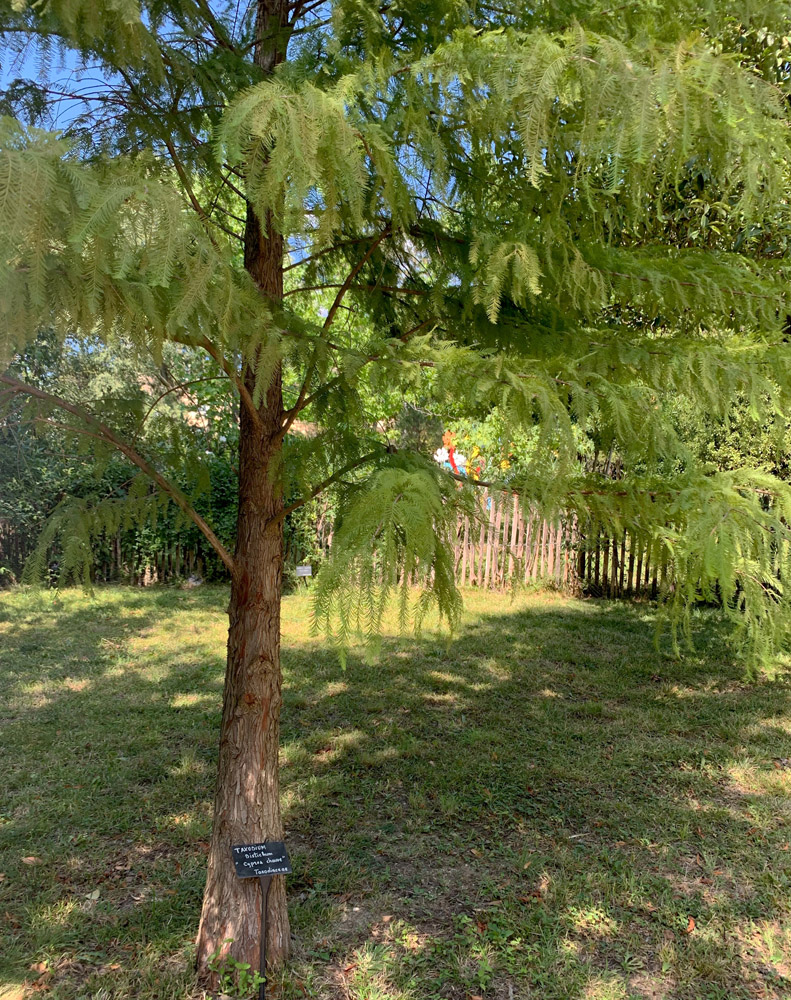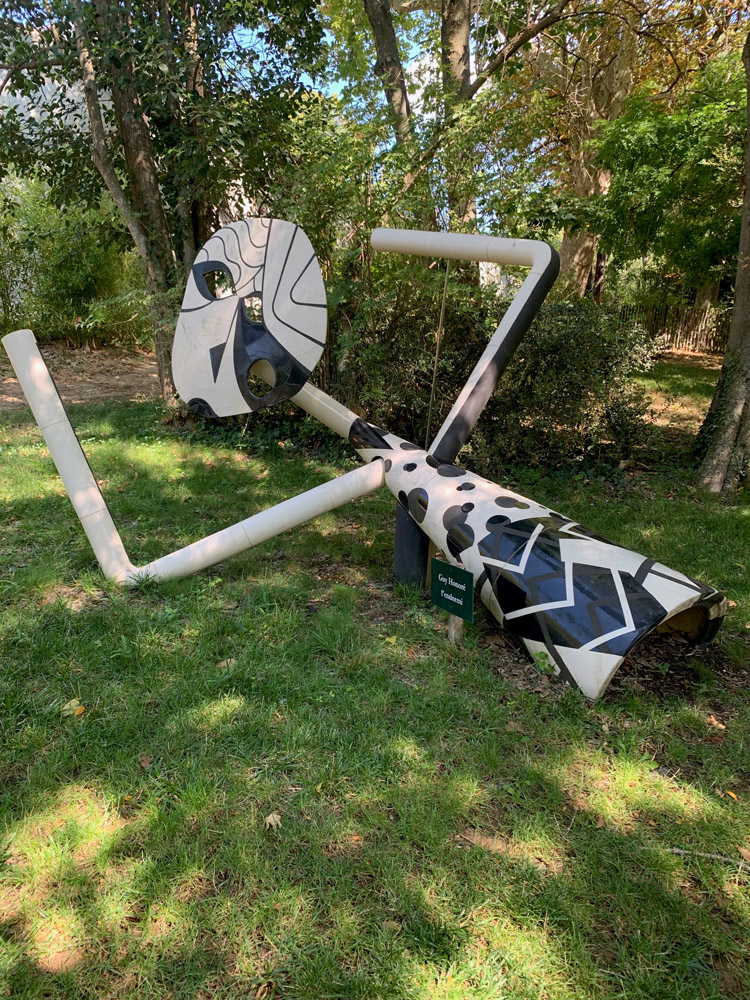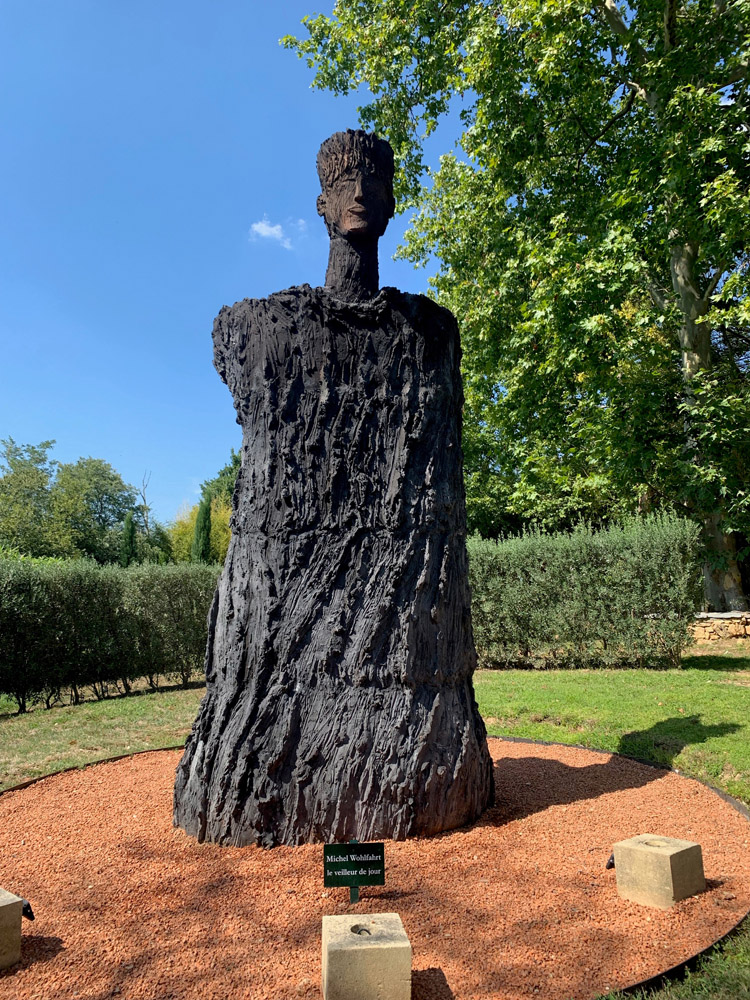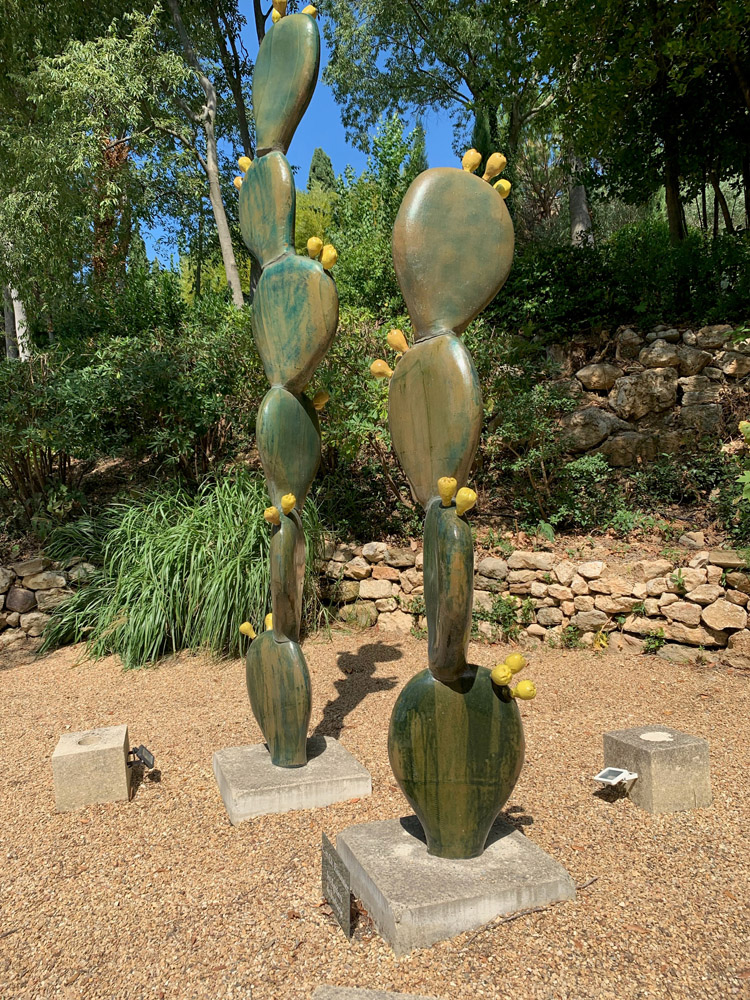August / août 2019
Petty, Pottery & Co – A pottery themed outing
Click on an image to enlarge it / Cliquez sur une image pour l’agrandir
This outing, organised by Julia Petty and Chantal Guiraud had ‘pottery’ as its theme. The day began with a visit to the Pottery Museum in Saint-Quentin-la-Poterie, then members strolled at their leisure through the narrow village streets, visiting pottery workshops along the way.
Cette sortie autour du thème de la poterie était organisée par Julia Petty et Chantal Guiraud. La journée a commencé par la visite du Musée de la Poterie à Saint-Quentin-la-Poterie, puis chacun a pu déambuler à sa guise dans les ruelles de ce village afin de visiter les différents ateliers de poterie.

La Fontaine du Griffe, réhabilitée en 1983, par l’artiste Martine Lafon avec l’aide des habitants.
The fountain is decorated with hundreds of ‘tessons de poteries’ (broken pieces of old pots, found in the surrounding area).
La fontaine est composée de centaines de tessons de poteries (morceaux anciens que l’on trouve dans les alentours).
At lunchtime, Julia and Graham kindly invited us to their home for a picnic. We admired the beautiful garden they have created, which sits in harmony with the surrounding ‘garrigue’ landscape, and the lovingly cultivated plants in pots on the shady terrace. Julia is not only an accomplished gardener but also a talented potter, hush!…. it’s a secret!
Ensuite, Julia et Graham nous ont gentiment accueillis chez eux pour un pique-nique. Nous avons pu admirer l’énorme travail fait par les propriétaires dans ce jardin en harmonie avec la garrigue alentour et les plantes cultivées avec amour en pots sur leur terrasse ombrée. Julia est non seulement une jardinière accomplie mais aussi une artiste potière, shut !….c’est un secret…..
Next we visited the Jardin des Oules, in the village of Saint-Victor-des-Oules, not far from Uzès. ‘Oules’ are pots which have been made in the village for many centuries. The walled garden of 1.9 hectares is typical of gardens created around the grand houses built in the 19th century.
Nous avons visité ensuite le Jardin des Oules situé dans le village de Saint-Victor-des-Oules, pas très loin d’Uzès. Les « oules » sont les marmites fabriquées dans ce village depuis des siècles. Le jardin clos de murs d’environ 1,9 hectares est typique des jardins créés autour des belles demeures du 19ème siècle.
Mme Delvaux, the owner, explained that when she first saw the garden, it had been abandoned for 50 years. No longer a garden, it had become an amazing virgin forest, rather like Le Jardin de la rue Plumet in Victor Hugo’s les Misérables. Over a two year period, the passion and imagination of the new owners and their love of the place was the driving force behind a whirlwind of activity.
Mme Delvaux, la propriétaire, nous a expliqué que lors de sa première visite, le jardin était abandonné depuis 50 ans. Il était, non plus un jardin, mais une extraordinaire forêt vierge, un peu comme le jardin de la rue Plumet dans les Misérables de Victor Hugo. La passion et l’imagination des nouveaux propriétaires et leur amour pour ce lieu ont été le véritable moteur du tourbillon d’aménagements durant deux années.
Clearing the garden undergrowth revealed some beautiful and majestic specimen trees. There were planes, chestnuts, maples and limes and other rarer species, calocedrus, cephalotaxus, a tall rhamnus and several Buxus balearica. The groundwork was undertaken by a close-knit group of local artisans who were passionate about the renovation. They remain inseparable partners in the project.
The talented landscape gardener, Emmanuel de Sauveboeuf, has a passion for restoring lost gardens. He succeeded in revealing the original bones of the garden then strengthened the design with new planting to give the place substantive interest throughout the year. This includes trees and shrubs with a long flowering period, some with delicate scents and some which give good autumn colour. Other plants were selected for their historical relevance, for example plants which were collected worldwide on botanical expeditions in the 19th century.
Le débroussaillage du jardin révéla de beaux arbres majestueux. Il y avait des platanes, des marronniers, des érables, des tilleuls et des espèces rares comme le calocedrus, le cephalotaxus, un très grand rhamnus et plusieurs Buxus balearica. Le projet fut pris en main par une équipe soudée d’artisans locaux passionnés par cette rénovation. Ils sont restés des partenaires inséparables.
The talented landscape gardener, Emmanuel de Sauveboeuf, has a passion for restoring lost gardens. He succeeded in revealing the original bones of the garden then strengthened the design with new planting to give the place substantive interest throughout the year. This includes trees and shrubs with a long flowering period, some with delicate scents and some which give good autumn colour. Other plants were selected for their historical relevance, for example plants which were collected worldwide on botanical expeditions in the 19th century.
A maze was created from 1,200 pyramidal olive trees and a similar number of bamboos. An outdoor theatre, typically included in the gardens of grand 19th century houses, was designed by Frédéric Sichet, as the final touch.
The water features, comprising two grottoes, the river and the ponds, have been fully restored with help from the Parcs et Jardins de France and the Boston chapter of French Heritage Society. Sadly, the grottoes were not functioning at the time of our visit because of the fall in the water table and the heatwave. A number of plants had also died.
Un labyrinthe fut créé à partir de 1200 oliviers pyramidaux mélangés à autant de bambous. Un théâtre de verdure, dessiné par Frédéric Sichet fut la touche finale de ce jardin, si typique des grandes demeures du 19ème siècle.
Le parcours hydraulique, comprenant deux grottes, la rivière et les bassins, a été complètement restauré avec l’aide des Parcs et Jardins de France et de la branche de Boston de la French Heritage Society. Malheureusement, les grottes ne fonctionnaient pas lors de notre visite, à cause du bas niveau de la nappe phréatique et de la canicule. Quelques plantes avaient également succombé à la chaleur estivale.
Mr and Mme Delvaux had commissioned a collection of large sculptures made by local artists. These reinforced the theme of romanticism and endorsed the entire garden project, anchored in the history and art of the region.
Mr et Mme Delvaux ont réunis une collection de grandes sculptures en céramique réalisées par des artistes locaux, illustrant ainsi le thème du romantisme et affirmant le projet général du jardin, ancré dans l’histoire et l’art de la région.
Text: Julia Petty and Chantal Guiraud
Photos: David Ash
![]()






